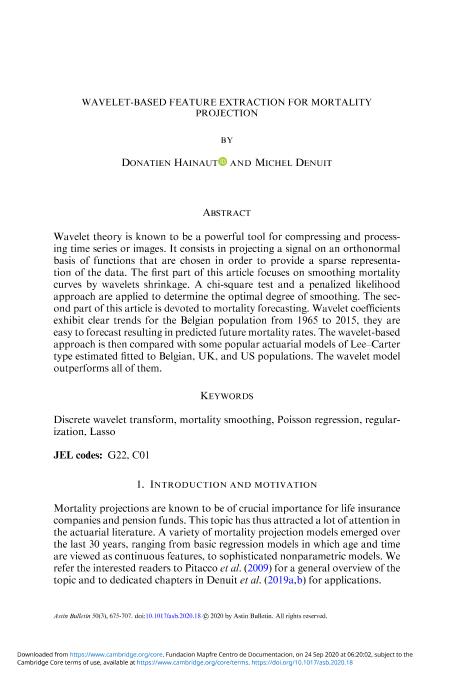Wavelet-based feature extraction for mortality projection

Contenido multimedia no disponible por derechos de autor o por acceso restringido. Contacte con la institución para más información.
| Tag | 1 | 2 | Value |
|---|---|---|---|
| LDR | 00000cab a2200000 4500 | ||
| 001 | MAP20200029700 | ||
| 003 | MAP | ||
| 005 | 20200924174727.0 | ||
| 008 | 200924e20200901bel|||p |0|||b|eng d | ||
| 040 | $aMAP$bspa$dMAP | ||
| 084 | $a6 | ||
| 100 | $0MAPA20180010453$aHainaut, Donatien | ||
| 245 | 1 | 0 | $aWavelet-based feature extraction for mortality projection$cDonatien Hainaut, Michel Denuit |
| 520 | $aWavelet theory is known to be a powerful tool for compressing and processing time series or images. It consists in projecting a signal on an orthonormal basis of functions that are chosen in order to provide a sparse representation of the data. The first part of this article focuses on smoothing mortality curves by wavelets shrinkage. A chi-square test and a penalized likelihood approach are applied to determine the optimal degree of smoothing. The second part of this article is devoted to mortality forecasting. Wavelet coefficients exhibit clear trends for the Belgian population from 1965 to 2015, they are easy to forecast resulting in predicted future mortality rates. The wavelet-based approach is then compared with some popular actuarial models of LeeCarter type estimated fitted to Belgian, UK, and US populations. The wavelet model outperforms all of them. | ||
| 650 | 4 | $0MAPA20080579258$aCálculo actuarial | |
| 650 | 4 | $0MAPA20080592042$aModelos matemáticos | |
| 650 | 4 | $0MAPA20080555306$aMortalidad | |
| 650 | 4 | $0MAPA20120011137$aPredicciones estadísticas | |
| 650 | 4 | $0MAPA20080592011$aModelos actuariales | |
| 650 | 4 | $0MAPA20090041721$aDistribución Poisson-Beta | |
| 700 | 1 | $0MAPA20080096434$aDenuit, Michel | |
| 773 | 0 | $wMAP20077000420$tAstin bulletin$dBelgium : ASTIN and AFIR Sections of the International Actuarial Association$x0515-0361$g01/09/2020 Volumen 50 Número 3 - septiembre 2020 , p. 675-707 |

